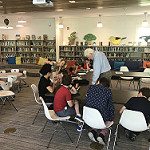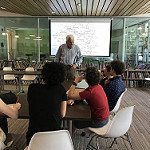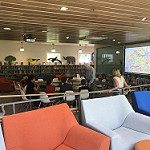On Monday May 21 I had the pleasure of introducing my 7th grade French students to my father-in-law, Philippe Daire, who is currently visiting from France.
Philippe was born in Paris in 1934, and was 5 years old when World War II broke out in Europe.
He spent 40 minutes with our class telling the students about his childhood, how his mother had to send him to ‘La France Libre’ (Southwest France) where the German army had not yet claimed control, to live with his grandparents, as Paris fell to the German army in 1940. For more than 5 years of his early childhood, he was seperated from his parents; he barely knew his mother, as she had to remain in Paris to work, while his father, Maurice Daire, a member of the French army, was taken as a prisoner of war and was held for several years in a German work camp in Austria.
Philippe was 11 years old when he saw his father again.
Philippe’s father-in-law, Roger Leduc, was a member of the French Résistance movement, and he spoke to the way that this collection of civilian “soldiers” fought against the Nazi German occupation of France and against the collaborationist Vichy régime during the Second World War. He told the students how English bombers would fly over the channel and drop military rations by parachute to the Résistance troups hiding deep in the forests of France.
It was a unique and rare experience to be able to hear a firsthand account of life in France during World War II, to learn how his life was affected, starting with what a child would notice the most… a shortage of chocolate, to the more severe and debilitating results of the war such as food & coal rationing, to clothing rationing, as with each year supplies grew more scarce and prices grew higher. Young French men were sent to Germany for STO (service de travail obligatoire) to run the German factories and be their work force … and for men such as Philippe’s father-in-law who decided not to join the STO to instead become become freedom fighters/ aka La Resistance who answered the call of General DeGaulle to fight behind the lines of the German occupied France in the effort to sabotage and slow down their forces.
Philippe shared with the students his emotions, the emotions that he can remember, of feeling utterly hopeless in the face of the German army, to the glimmer of hope that arrived in the form of American ‘flying air-fortresses’ that could be heard flying high above France in 1944 & 1945.
The students prepared questions to ask Philippe at the end of his presentation, ranging from inquiries regarding his personal experience of growing up during the war, to whether or not he had ever met a Nazi. He told of his encounter with a young German soldier in the streets of his village in the La France ‘libre’, one who was barely 18 years old, how through a child’s eyes the man seemed normal and kind, but how the terrifying reality of why he was in France and what he was a part of would haunt him for the rest of his life.
I feel that our students found Philippe’s visit to be enlightening and special, as with each day, month and year that pass our world sees fewer and fewer survivors of World War II.
I hope that they will remember his words in the years to come as they begin to study WW II in more depth in their Upper School and High School history classes.
Madame Daire



